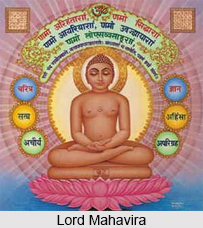 Lord Mahavira was the twenty-fourth and last Tirthankara of Jain religion. Mahavir was born in 599 B.C. as a prince in Bihar. Though Mahavira was born with all worldly comforts and luxuries, they never attracted him. He lived a simple life detached from all materialistic desires. When his parents died, he decided to be a monk.
Lord Mahavira was the twenty-fourth and last Tirthankara of Jain religion. Mahavir was born in 599 B.C. as a prince in Bihar. Though Mahavira was born with all worldly comforts and luxuries, they never attracted him. He lived a simple life detached from all materialistic desires. When his parents died, he decided to be a monk.
Renunciation of Lord Mahavira
At the age of thirty Mahavira gave up his worldly life and all worldly activities. He left his home for a lonely forest, called Gnatnshanda or Jnatrkhandavana, which was located near his home town. His elder brother, Nandi Vardhana and his sister, Sudarsana, were there, but they could not prevent Mahavira from embracing the ascetic life.
Mahavira had first joined the order of Parshvanatha. Even his parents were his followers. According to the Digambaras Mahavira had abandoned his clothes at the time of his initiation, whereas the Swetambaras believe that he abandoned them after thirteen months. Mahavira meditated for twelve years on the supreme path for final liberation. He spent most of his time in austerity and in meditation. He spent the next twelve years in deep silence and meditation to conquer his desires and feelings. He lived without food for long periods. He carefully avoided harming or annoying other living beings that also included animals, birds, and plants. He suffered a great deal of physical pain and torture from various sources. Among them, the most severe was the biting by the highly poisonous snake Chandakaushik. Lord Mahavira remained calm and peaceful in the midst of all these torturous events. His ways of meditation, days of austerities, and form of behaviour stand as a perfect example for monks and nuns in religious life. His spiritual pursuit lasted for twelve years at the end of which he realized the perfect perception, knowledge, power, and bliss.
Kevalgyana of Lord Mahavira
Mahavira attained supreme enlightenment at the age of fourtytwo, in the thirteenth year of his renunciation. The event took place on the tenth day of the bright fortnight in the month of Vaisakha on the north bank of the river Rijupalika or Rituvalika under a Sala tree. The place was located in the village of Jambhiyagama.
Wanderings of Lord Mahavira
Lord Mahavira after attaining Kevalgyana wandered to different places preaching people about the eternal truth. The last thirty years of Mahavira were passed in travelling on bare feet all over India. He taught about his religious system, organising order of ascetics, preaching his doctrines and making converts. Mahavira wandered about in Bihar and some parts of Uttar Pradesh and West Bengal. While traveling to different places he attracted people from all walks of life, rich and poor, kings and commoners, men and women, princes and priests. Once Gosala met Mahavira in Nalanda were he was wandering. He was very impressed by Mahavira and later became his disciple. They together lived together for six years in Paniyabhumi practising asceticism. Influence of Mahavira in Gosala`s Life left a deep impact. Later Gosala formed the Ajivika Sect.
According to Vrhatakalpasutra, while at Saketa in Ayodhya, Mahavira told his disciples that they were permitted to go only upto Magadha in the east, Kausambi in the south, Sthaneshwar or Sthuna in the west and Kunala (Sravasti) in the north, as only these areas were Aryakshetra. During the rainy seasons he spent most of his time in the native towns of Vaishali, Rajagriha (the old capital of Magadha), Champa (the capital of ancient Anga, Mithila (the kingdom of Videha) and Sravasti.
The Kalpa Sutra gives the names of the places where Mahavira stayed during the rainy seasons after he renounced the world. Mahavira spent the first rainy season in Asthikagrama, three in Champa and Pristha Champa, twelve in Vaishali and Vanijyagrama, fourteen in Rajagriha and suburb of Nalanda, six in Mithila, two in Bhadrika, one in Alabhika, one in Paniyabhumi, one in Sravasti and the last one in the town of Pava, in king Hastipala`s office.









